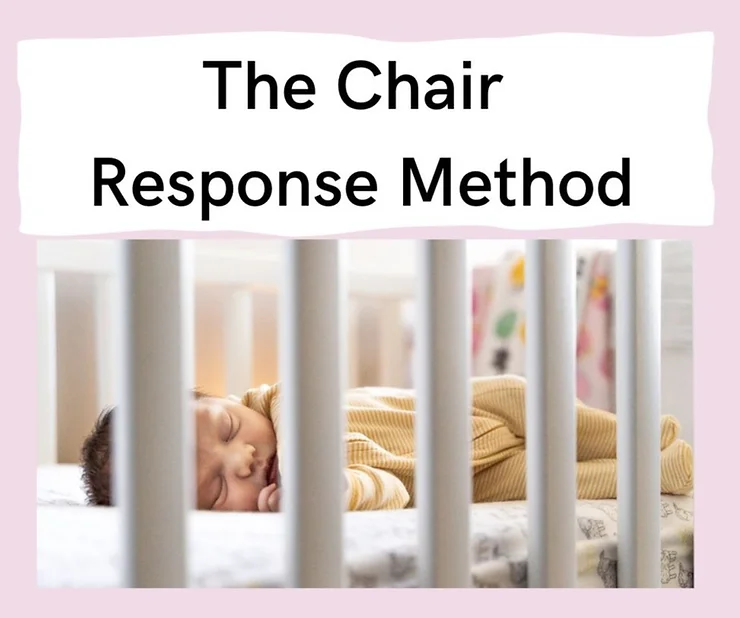A very involved method is called the Chair Method. This is perfect for parents who are ready to make big changes toward improving their children’s healthy independent sleep skills, and prefer a gradual method that allows for a lot of parental involvement throughout the process.
While this method allows for plenty of parental involvement, it is important to recognize that change is hard for babies, children, and even adults. So even though it is a more gradual process, it’s realistic to expect big feelings and protest from your child. The most important as aspect of any plan is the consistency in which the plan is implemented along with all of the background work (addressing the sleep environment, schedules, routines around sleep, and age appropriate preparation and celebration for the big kids)
The chair method involves placing a chair next to your child’s safe sleep space. The chair is where you will sit after the bedtime routine ends. You will sit calmly and mostly quietly until your child falls into a deep sleep and you can leave the room. This is also how you will respond to each night waking until your pre-determined OK to Wake time in the morning.
It’s important to note that the chair you sit on is not a chair that already lives in your child’s room. This chair needs to be one that will gradually leave the room over the course of the next 1-2 weeks. It’s also important that you’re not falling asleep in the chair or lying on the floor or bed. This can be really hard when you’re tired in the middle of the night! But it’s important to stay consistent so you can get through the process smoothly and get to the other side where your child is comfortable sleeping alone in their safe sleep space without a grownup right beside them.
The chair is placed right next to the child’s safe sleep space for the first 2-3 nights. Then the chair moves to the middle of the room where it stays, and you sit, for the following 2-3 nights. Next, the chair moves next to the bedroom door where it stays, and you sit for the following 2-3 nights. Finally, the chair leaves the room, and you might choose to “sit” right outside the door, and offer intermittent checks every 5-10 minutes until you child falls asleep at bedtime and during all night wakings.
It involves leaving calmly and confidently the room after the end of the perfectly predictable bedtime routine. However, once your child starts to protest and exhibit those big feelings (because change is hard!) one parent will calmly walk right back into the room to sit in the chair.
It’s so very helpful to practice staying in the chair and only infrequently using your voice as a soothing tool. Too much talking, or standing up can be distracting and confusing. Instead, use your calm presence in their room to demonstrate the calm behavior you want to see from them. You are supporting them throughout this learning process by being near them physically, but allowing them to practice their age appropriate independent sleep skills.
Returning to sit in the chair will be the exact same way you will respond to all night wakings as well until your previously agreed upon OK to Wake time.
If one night feed is appropriate, a caregiver will offer that feed immediately at the baby’s first waking after midnight. Once the feed ends, the baby will go right back to their safe sleep space and the caregiver can return to the chair until they are asleep!
It’s also helpful to consider who is going to be sitting in the chair. Oftentimes, there is one parent in the family who has a harder time holding firm boundaries, and may also the parent that does the bulk of the middle of the night soothing. In this type of family dynamic, there might also be another parent that has an easier time holding firmer boundaries. It is often helpful to have the parent who tends to have an easier time holding firmer boundaries be the parent who sits in the chair. Not only will this parent have an easier time staying consistent, but the child tends to also have an easier time accepting firm boundaries from this parent. And then the parent who will have a harder time with this process, is freed up to focus on other more distracting activities or to leave the house altogether and have wine with a close and non-judgemental (!) friend 🙂
I also work with many families who report no difference in boundary holding abilities, or who prefer to share the load equally for whatever reason. It’s also OK to take turns sitting in the chair so no one is ending up more or less sleep deprived! It is important, however, that you are not alternating parents until your child has already fallen asleep. You do not ever want your child thinking that they will get to see Mom after crying for any amount of minutes. Instead, you might say one parent takes bedtime, while the other parent takes the first night waking, and so on until morning.
This method is excellent for teaching babies over the age of 4 months, toddlers, and preschool aged children independent sleep skills. However, the response method is only one part of the healthy sleep equation or puzzle. It’s even more important to ensure that sleep hygiene has been fully addressed, as well as age appropriate preparation and celebration for our big kids.
If you feel ready to make a change and have regular long nights of sleep back for the whole family, don’t hesitate to ask for help. Schedule a free 15 minute discovery call to learn more about how I can work with you to create a personalized sleep plan for your family and provide daily support along the way while you reach your goals.

